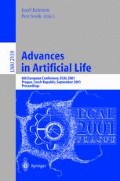Abstract
Acquisition of self-maintenance of cell membranes is an essential step to evolve from molecular to cellular reproduction. In this report, we present a model of artificial chemistry that simulates metabolic reactions, diffusion and repulsion of abstract chemicals in a two-dimensional space to realize the organization of proto-cell structures. It demonstrates that proto-cell structures that maintain and reproduce themselves autonomously emerge from a non-organized initial configuration. The results also suggest that a metabolic system that produces membranes can be selected in the chemical evolution of a pre-cellular stage.
Access this chapter
Tax calculation will be finalised at checkout
Purchases are for personal use only
Preview
Unable to display preview. Download preview PDF.
References
Bachmann, P. A., Luisi, P. L. and Lang, J. Autocatalytic Self-Replicationg Micelles as Models for Prebiotic Structures, Nautre, 357 (1992), 57–59.
Breyer, J., Ackermann, J. and McCaskill, J. Evolving Reaction-Diffusion Ecosystems with Self-Assembling Structures in Thin Films, Artificial Life, 4 (1998), 25–40.
Cronhjort, M. B. and Blomberg, C. Cluster Compartmentalization may Provide Resistance to Parasites for Catalytic Networks, Physica D, 101 (1997), 289–298.
Eigen, M. and Schuster, P. The Hypercycle. A Principle of Natural SelfOrganization, Springer-Verlag, Berlin; New York (1979).
Eigen, M., Schuster, P., Gardiner, W. and Winkler-Oswatitsch, R. The Origin of Genetic Information, Scientific American, 244, 4(1981), 78–94.
Gánti, T. Organization of Chemical Reactions into Dividing and Metabolizing Units: The Chemotons, BioSystems, 7 (1975), 15–21.
Gánti, T. Biogenesis Itself, J. theol. Biol., 187 (1997), 583–593.
Kauffman, S. A. Investigation, Oxford University Press (2000).
Lee, K. J., Mccormick, W. D., Pearson, J. E. and Swinney, H. L. Experimental Observation of Self-Replication Spots in a Reaction Diffusion System, Nature, 369 (1994), 215–218.
Maturana, H. R. and Varela, F. J. Autopoiesis and Cognition: the Realization of the Living, D. Reidel Publishing (1980).
Maturana, H. R. and Varela, F. J. The Tree of Knowledge, Shambhala Publications (1987).
Maynard Smith, J. and Szathmáry, E. The Major Transitions in Evolution, Oxford: Freeman & Co. (1995).
McMullin, B. and Varela, F. J. Rediscovering Computational Autopoiesis, 4th European Conference on Artificial Life (eds. Husbands, P. and Harvey, I.), Brighton, UK (Jul 1997), MIT press.
Meinhardt, H. Models of Biological Pattern Formation, Academic Press, London (1982).
Ono, N. and Ikegami, T. Model of Self-Replicating Cell Capable of SelfMaintenance, Proceedings of the 5th European Conference on Artificial Life (ECA’99) (eds.Floreano, D., Nicoud, J. D. and Mondada, F.), Lausanne, Switzerland (1999), Springer.
Ono, N. and Ikegami, T. Self-Maintenance and Self-Reproduction in an Abstract Cell Model, J. theor. Biol., 206 (2000), 243–253.
Ono, N. Ph.D. thesis, Artificial Chemistry: Computational Studies on the Emergence of Self-Reproducing Units, Univ. of Tokyo, (March 2001).
Segre, D., Ben-Eli, D., Deamer, D. and Lancet, D. The Lipid World, Orig. Life Evol. Biosph. (2000).
Szathmáry, E. and Demeter, L. Group Selection of Early Replicators and the Origin of Life, J. theor. Biol., 128 (1987), 463–486.
Szathmáry, E. and Maynard Smith, J. From Replicators to Reproducers: the First Major Transitions Leading to Life, J. theor. Biol, 187 (1997), 555–571.
Turing, A. M. The Chemical Basis of Morphogenesis, Philosophical Transactions of the Royal Society (part B), 237 (1953), 37–72, (Reprinted in Bulletin of Mathematical Biology (1990) 52, No.1/2 153-197).
Varela, F. J., Maturana, H. R. and Uribe, R. Autopoiesis: The Organization of Living Systems, its Characterization and a Model., BioSystems, 5 (1974), 187–196.
Walde, P., Wich, R., Fresta, M., Mangone, A. and Luisi, P. L. Autopoietic Self-Reproduction of Fatty Acid Vesicles., Jounal of American Chemical Society, 116 (1994), 11649–11654.
Author information
Authors and Affiliations
Editor information
Editors and Affiliations
Rights and permissions
Copyright information
© 2001 Springer-Verlag Berlin Heidelberg
About this paper
Cite this paper
Ono, N., Ikegami, T. (2001). Artificial Chemistry: Computational Studies on the Emergence of Self-Reproducing Units. In: Kelemen, J., Sosík, P. (eds) Advances in Artificial Life. ECAL 2001. Lecture Notes in Computer Science(), vol 2159. Springer, Berlin, Heidelberg. https://doi.org/10.1007/3-540-44811-X_20
Download citation
DOI: https://doi.org/10.1007/3-540-44811-X_20
Published:
Publisher Name: Springer, Berlin, Heidelberg
Print ISBN: 978-3-540-42567-0
Online ISBN: 978-3-540-44811-2
eBook Packages: Springer Book Archive

